Abstract
1. Energy balance and brown adipose tissue growth were examined in four groups of male Wistar rats: (i) sedentary, living at 24 degrees C (warm), (ii) exercise-trained, 2 h daily, living at 24 degrees C, (iii) living at 24 degrees C but exposed to -5 degrees C, 2 h daily and (iv) living at 24 degrees C but exercise-trained while being exposed to -5 degrees C, 2 h daily. 2. Cold exposure during exercise training appeared to have little additional influence on body composition following 28 days of treatment; body mass gain, in addition to protein and fat gains, of exercised cold-exposed rats were similar to the gains observed in exercised warm-exposed control animals. However, in sedentary cold-exposed rats protein, fat and body mass gains were significantly lower than the gains measured in sedentary rats not exposed to cold. 3. Metabolizable energy intake, expressed mass-independently, was similar in sedentary warm-exposed rats and both groups of animals that were exercise-trained. Metabolizable energy intake was increased almost 15% in sedentary cold-exposed rats. 4. Energy expenditure (mass independent), excluding the net cost of exercise training, was not different in sedentary warm-exposed and exercised rats; energy expenditure was almost 20% higher in sedentary cold-exposed rats. 5. Total protein and deoxyribonucleic acid (DNA) contents of brown adipose tissue were more than doubled in sedentary rats exposed to cold; protein and DNA levels were similar among the other three groups of rats. 6. Treadmill running during daily, 2 h exposure at -5 degrees C appears to prevent the cold acclimation responses that occur in sedentary rats receiving similar cold exposure.
Full text
PDF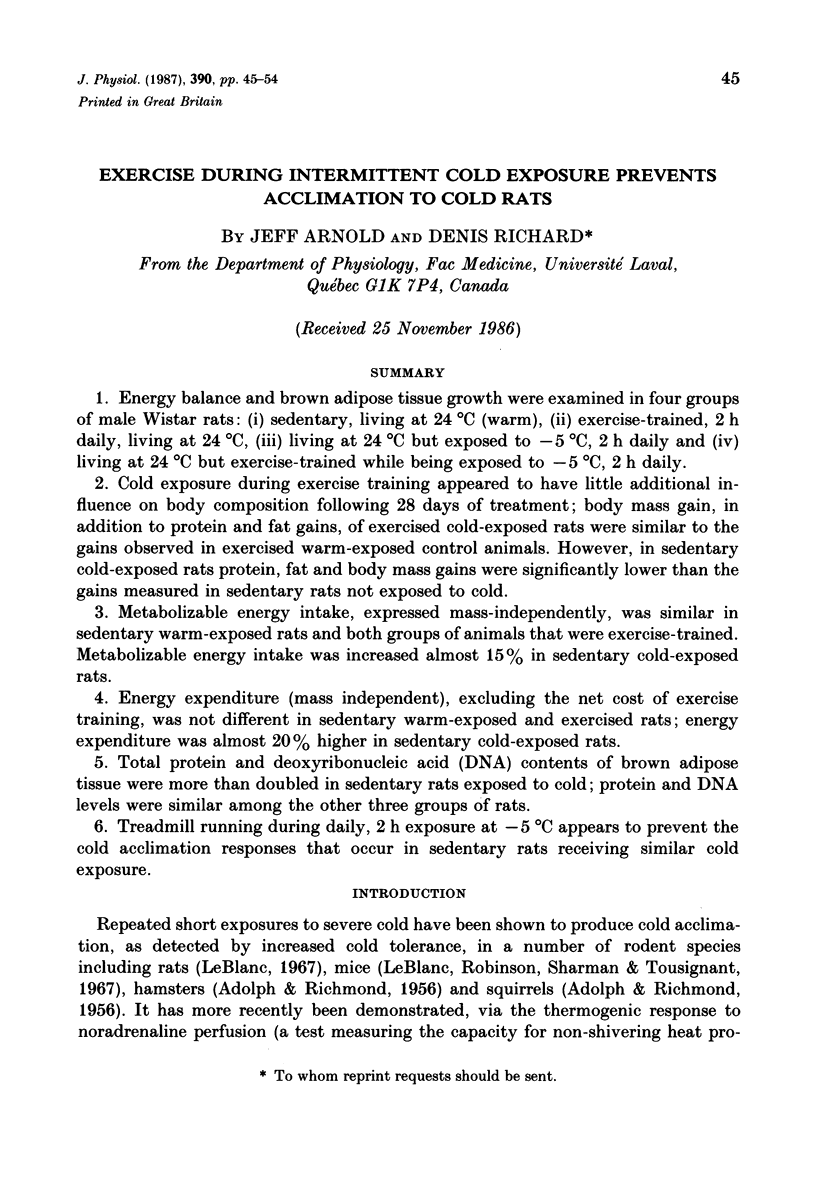
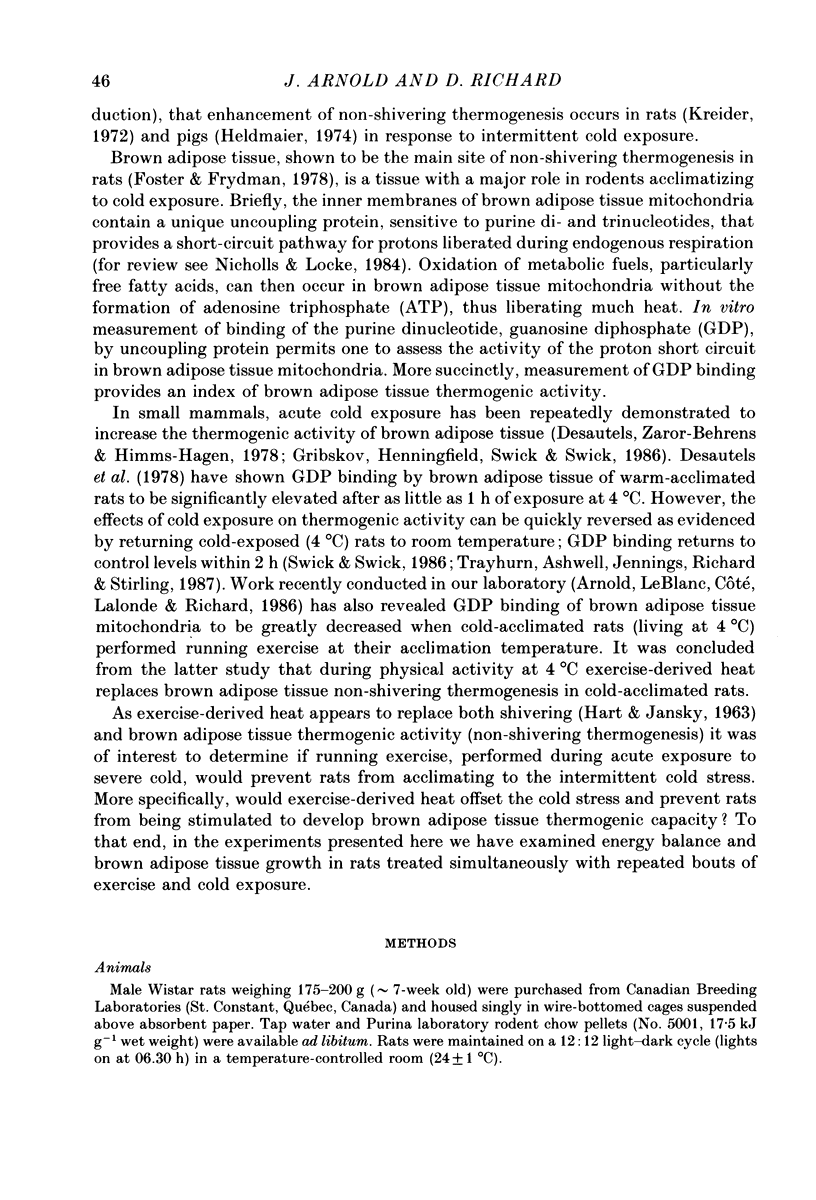

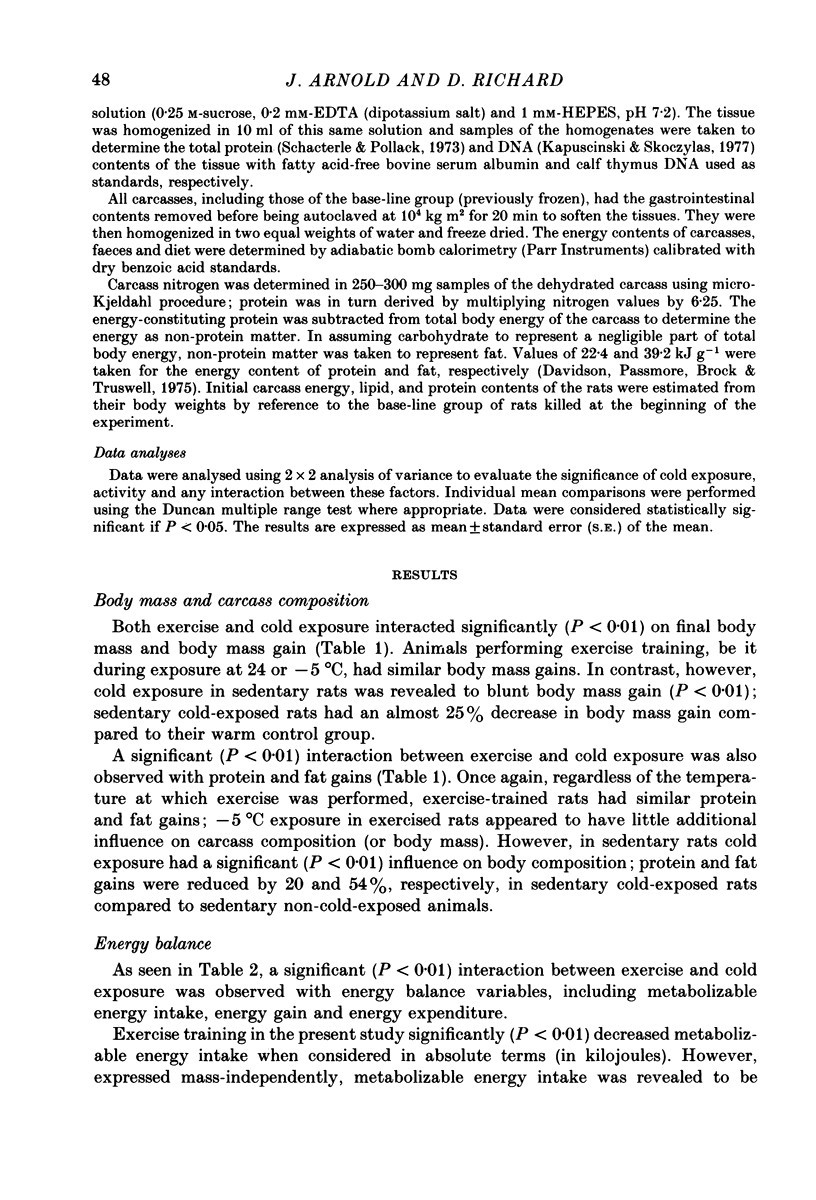


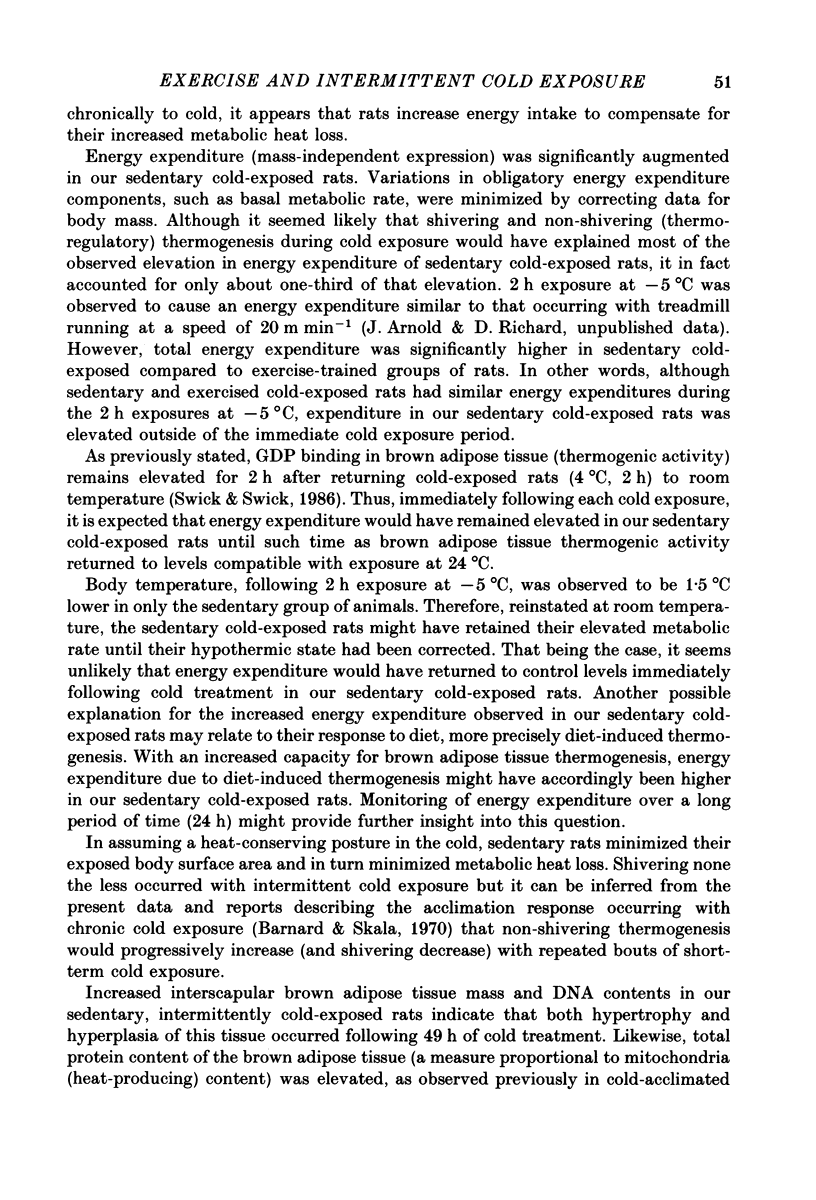


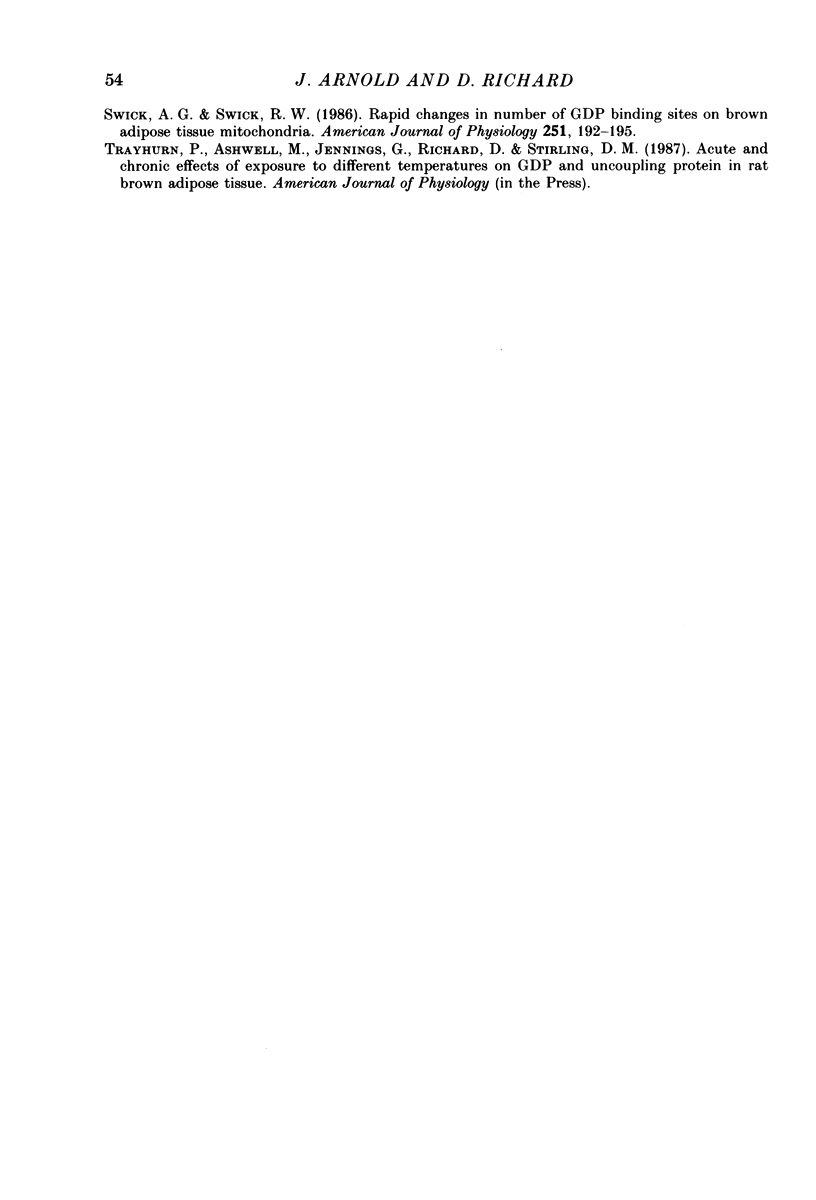
Selected References
These references are in PubMed. This may not be the complete list of references from this article.
- ADOLPH E. F., RICHMOND J. Adaptation to cold in golden hamster and ground squirrel measured chiefly by rates of body cooling. J Appl Physiol. 1956 Jul;9(1):53–58. doi: 10.1152/jappl.1956.9.1.53. [DOI] [PubMed] [Google Scholar]
- Arnold J., LeBlanc J., Cote J., Lalonde J., Richard D. Exercise suppression of thermoregulatory thermogenesis in warm- and cold-acclimated rats. Can J Physiol Pharmacol. 1986 Jul;64(7):922–926. doi: 10.1139/y86-158. [DOI] [PubMed] [Google Scholar]
- Berger M., Kemmer F. W., Becker K., Herberg L., Schwenen M., Gjinavci A., Berchtold P. Effect of physical training on glucose tolerance and on glucose metabolism of skeletal muscle in anaesthetized normal rats. Diabetologia. 1979 Mar;16(3):179–184. doi: 10.1007/BF01219795. [DOI] [PubMed] [Google Scholar]
- Desautels M., Zaror-Behrens G., Himms-Hagen J. Increased purine nucleotide binding, altered polypeptide composition, and thermogenesis in brown adipose tissue mitochondria of cold-acclimated rats. Can J Biochem. 1978 Jun;56(6):378–383. doi: 10.1139/o78-060. [DOI] [PubMed] [Google Scholar]
- Foster D. O., Frydman M. L. Nonshivering thermogenesis in the rat. II. Measurements of blood flow with microspheres point to brown adipose tissue as the dominant site of the calorigenesis induced by noradrenaline. Can J Physiol Pharmacol. 1978 Feb;56(1):110–122. doi: 10.1139/y78-015. [DOI] [PubMed] [Google Scholar]
- Gribskov C. L., Henningfield M. F., Swick A. G., Swick R. W. Evidence for unmasking of rat brown-adipose-tissue mitochondrial GDP-binding sites in response to acute cold exposure. Effects of washing with albumin on GDP binding. Biochem J. 1986 Feb 1;233(3):743–747. doi: 10.1042/bj2330743. [DOI] [PMC free article] [PubMed] [Google Scholar]
- HART J. S., JANSKY L. Thermogenesis due to exercise and cold in warm- and cold-acclimated rats. Can J Biochem Physiol. 1963 Mar;41:629–634. [PubMed] [Google Scholar]
- Heldmaier G. Cold adaptation by short daily cold exposures in the young pig. J Appl Physiol. 1974 Feb;36(2):163–168. doi: 10.1152/jappl.1974.36.2.163. [DOI] [PubMed] [Google Scholar]
- Heusner A. A. Body size and energy metabolism. Annu Rev Nutr. 1985;5:267–293. doi: 10.1146/annurev.nu.05.070185.001411. [DOI] [PubMed] [Google Scholar]
- Kapuściński J., Skoczylas B. Simple and rapid fluorimetric method for DNA microassay. Anal Biochem. 1977 Nov;83(1):252–257. doi: 10.1016/0003-2697(77)90533-4. [DOI] [PubMed] [Google Scholar]
- LeBlanc J., Robinson D., Sharman D. F., Tousignant P. Catecholamines and short-term adaptation to cold in mice. Am J Physiol. 1967 Dec;213(6):1419–1422. doi: 10.1152/ajplegacy.1967.213.6.1419. [DOI] [PubMed] [Google Scholar]
- Leblanc J. Adaptation to cold in three hours. Am J Physiol. 1967 Feb;212(2):530–532. doi: 10.1152/ajplegacy.1967.212.2.530. [DOI] [PubMed] [Google Scholar]
- Mercer S. W., Trayhurn P. The development of insulin resistance in brown adipose tissue may impair the acute cold-induced activation of thermogenesis in genetically obese (ob/ob) mice. Biosci Rep. 1984 Nov;4(11):933–940. doi: 10.1007/BF01116891. [DOI] [PubMed] [Google Scholar]
- Nicholls D. G., Locke R. M. Thermogenic mechanisms in brown fat. Physiol Rev. 1984 Jan;64(1):1–64. doi: 10.1152/physrev.1984.64.1.1. [DOI] [PubMed] [Google Scholar]
- Richard D., Arnold J., Leblanc J. Energy balance in exercise-trained rats acclimated at two environmental temperatures. J Appl Physiol (1985) 1986 Mar;60(3):1054–1059. doi: 10.1152/jappl.1986.60.3.1054. [DOI] [PubMed] [Google Scholar]
- Schacterle G. R., Pollack R. L. A simplified method for the quantitative assay of small amounts of protein in biologic material. Anal Biochem. 1973 Feb;51(2):654–655. doi: 10.1016/0003-2697(73)90523-x. [DOI] [PubMed] [Google Scholar]


